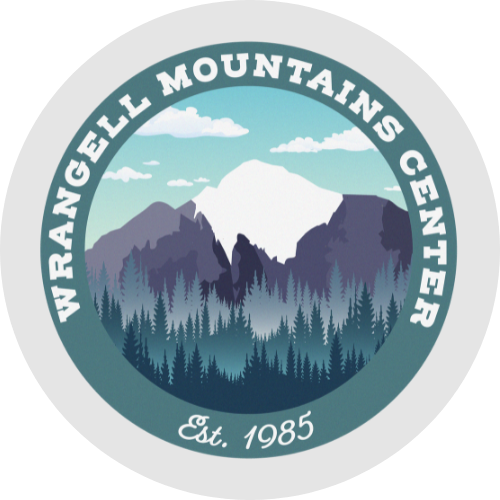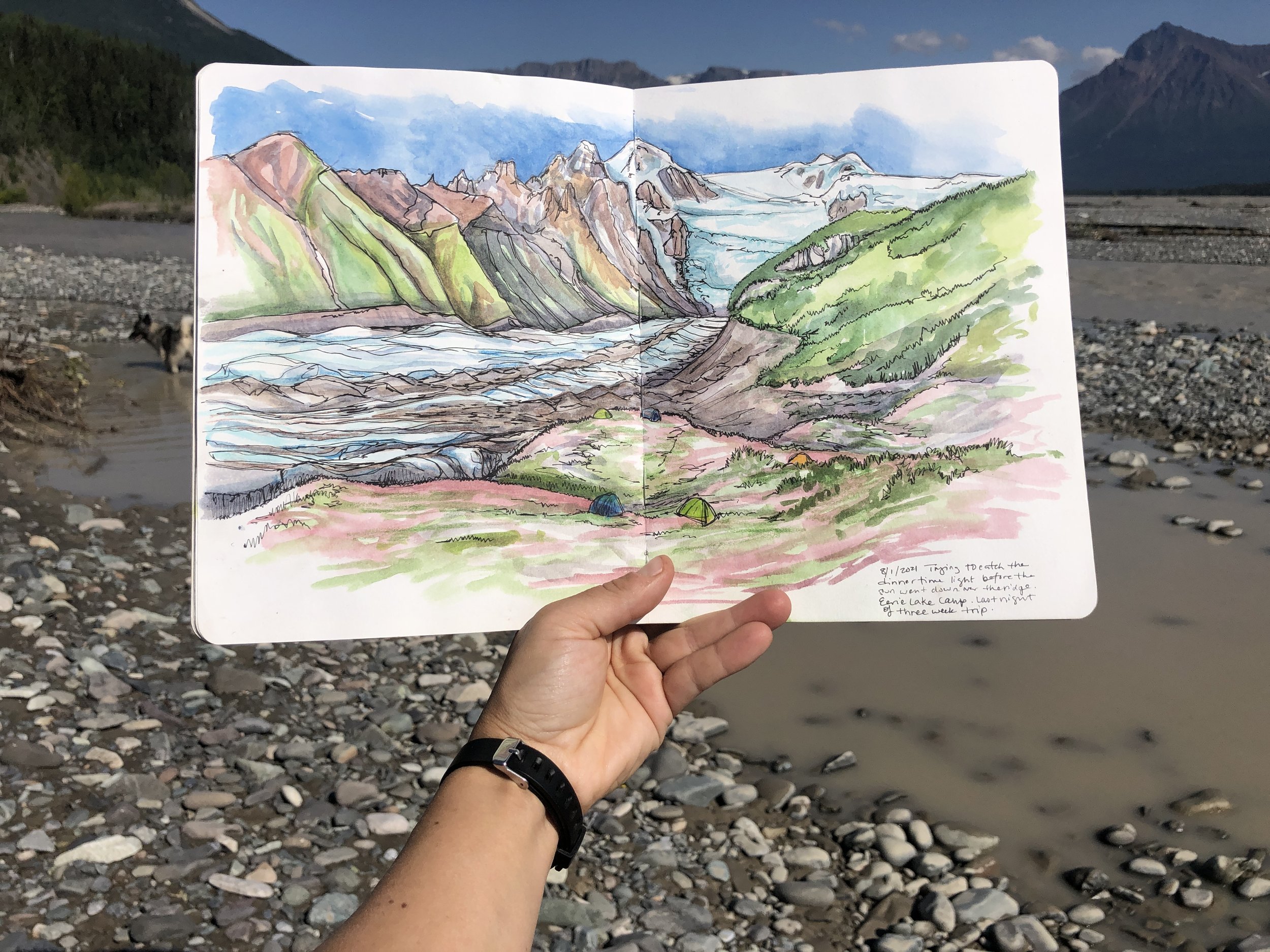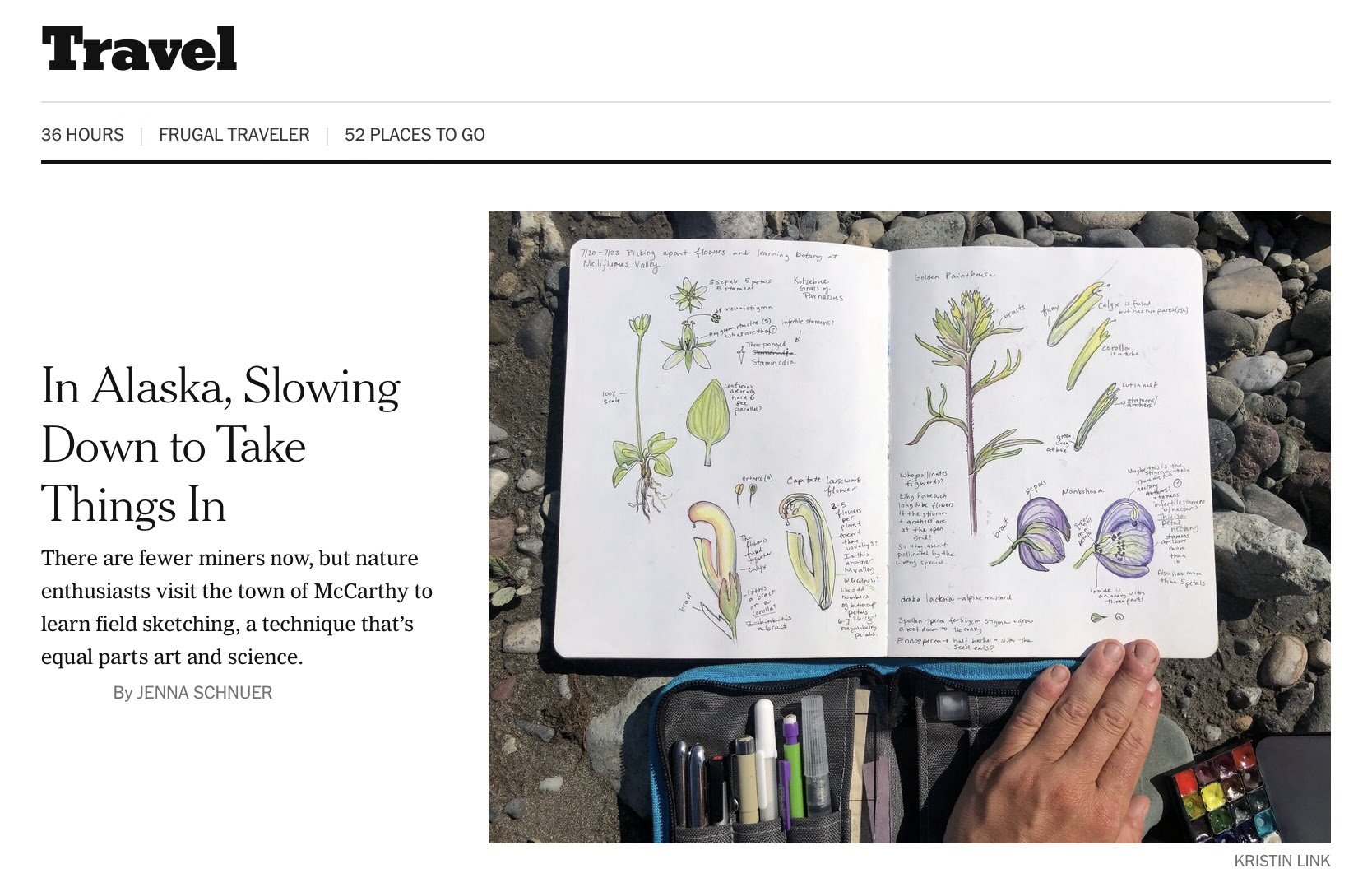Field Sketching & Journaling
with Kristin Link
Join Kristin for a two-day Workshop or an afternoon Community Sketching Group
Visit the Community Sketching Group page for more information
Read on for more information on the two-day Workshops
Workshop Dates
July 8-9, 2023
Session One: Introduction to Field Sketching Techniques
All skill levels welcome. Beginner focused, with basic drawing and watercolor sketching techniques.
July 15-16, 2023
Session Two: Approaches to Field Sketching
Join Illustrator Kristin Link in exploring the environment surrounding McCarthy in Wrangell-St. Elias National Park while practicing different field sketching techniques in this two-day workshop.
Please email info@wrangells.org if you have any questions.
A creative immersion
New this year: Two sessions focusing on different levels of experience.
Join us to combine science and art in a unique approach to learning about the natural world. Participants will explore the environment surrounding McCarthy, Alaska within Wrangell-St. Elias National Park while practicing different field sketching techniques including observational drawing, watercolor painting, and working with mixed media.
These workshops are appropriate for all levels of experience. The first session will focus on basic drawing and watercolor sketching techniques and the second session will build on those techniques with applied tools for field sketching. Join artist and science illustrator, Kristin Link, for a two-day introduction to nature journaling and field sketching. Kristin will share examples of her work, demonstrate techniques, and discuss approaches she uses as a science illustrator. Both workshops will include time for students to practice outside in the field. As a group, students will also get to learn from each other and share work.
Why keep a nature journal?
It can help to slow down and be present and grounded.
To create a record of observations and questions about the natural world.
To keep a regular drawing practice and develop my visual vocabulary, which I use as a science illustrator and artist.
It is a wonderful tool for beginning artists to create a practice and develop their own style.
A practice that combines art, place, and nature!
In these workshops, Kristin will share her own nature journaling practice and some of her favorite tools and techniques for creating accurate journal entries from the natural world. As a visual artist, the instruction focus will be on sketching and visual art, though we will also talk about including words and numbers in your journal pages.
Workshop participants will:
Learn multiple approaches to keeping a nature journal so that you can experiment and decide what works best for you.
Gain confidence in drawing from observation.
Learn techniques for working with mixed media, drawing with pen or pencil, and watercolor or colored pencil.
Learn an approach for capturing a variety of subjects in your journal such as plants, landscapes, animals, bones, and rocks.
Create multiple journal pages to record our time together.
Register
Important Notes
Early Bird price for each workshop is $300; After May 15, $350.
Each workshop is limited to 12 registrants
Cancellations/Refunds: Registrants may cancel for a full refund up to 90 days prior to the date of the workshop; Up to 60 days prior to workshop a 50% refund will be issued; No refund will be issued within 60 days of the workshop.
Need-based scholarships available for local residents.
Session One Workshop July 8-9
All skill levels welcome. Beginner focused, with basic drawing and watercolor sketching techniques.
This two-day workshop is an introduction to nature journaling and field sketching, and combines science and art in a unique approach to learning about the natural world. Participants will explore the environment surrounding McCarthy, Alaska in Wrangell-St. Elias National Park while experimenting with different field sketching techniques. Example topics include: drawing from observation making gesture, contour, negative space, and measured drawings; introduction to watercolor washes; exploration of mixed media; and applying techniques to different subjects such as plants, animals, and landscapes.
This workshop is limited to the first 12 registrants.
Artists of all levels, including absolute beginners, are welcome to attend. There will be a second session, a workshop on July 15-16, that builds on the techniques taught in this workshop. Students can sign up for both classes.
Session TWO Workshop July 15-16
This two-day workshop builds on skills from session one, and is for participants who have practice with basic drawing and watercolor painting, have taken a workshop with Kristin, or the equivalent. Please email info@wrangells.org if you have any questions.
Science and art is combined in a unique approach to learning about the natural world. Participants will explore the environment surrounding McCarthy, Alaska in Wrangell-St. Elias National Park while practicing different field sketching techniques — all designed for those looking to do a deeper dive into Kristin Link’s approach and technique for students who have a basic grasp of drawing and working with watercolor. Topics will include creating the illusion of space in a sketch, using selective detail, developing one’s visual vocabulary, and storytelling in the nature journal.
This workshop is limited to the first 12 registrants.
For those looking to learn the basics, there will be a beginner’s workshop on July 8-9. Participants are welcome to sign up for both sessions.
New York Times
Slowing Down to Take Things In
“I use Ms. Link’s suggestion of measuring far-off things with my pencil and then translating the length of those lines to paper to work. I draw slowly, looking from subject back to my paper again and again......”
“A practice that’s equal parts art and science, field sketching is used by researchers and artists to record their observations of nature, from waterways to winged creatures, mosses to mountaintops. Field sketching pairs illustrations with notes about weather, location, animal behavior and even the journal keeper’s mood that day, offering more context than a stand-alone photo. It’s also a powerful tool for travel, one that forces you to slow down, to take things in, to simply look. ”
Kristin Link
I've been working as an artist and illustrator in Alaska since receiving a graduate certificate in Science Illustration from CSUMB in 2010. I work to create images that explain and tell stories about the natural world. I hope my art inspired others to look closer at their own surroundings, and that this action will instill knowledge and conservation.
My work can be found on interpretive signs, in books about national parks, and in museums. I've exhibited illustrations and field sketches at the Alaska State Museum and received grants from the Rasmuson Foundation and the Alaska State Council on the Arts. I live in a cabin outside McCarthy, Alaska on the edge of the Wrangell-St. Elias National Park & Preserve.
Learn more about Kristin at www.kristinillustration.com and on follow on Instagram @linkkristin
““Kristin was well prepared with all of her presentations and she orchestrated the variety of activities perfectly! She was informative and gentle in her delivery. She differentiated her instructions to meet our range of readiness with seamless finesse.””
Meals and Accommodations
All meals will be provided and shared communally. Hot water will be available for coffee and tea. Every effort will be made to accommodate dietary needs and restrictions with advance notice. Primitive camping is available at no cost to workshop participants. The private site is located just a short walk away from the Wrangell Mountains Center campus. Those who camp are welcome to store gear and food, borrow bear barrels, and use our rustic shower and other facilities at the Hardware Store. WMC staff will direct you to the campsite and orient you there upon your arrival.
Other lodging options within McCarthy include the full service McCarthy Lodge and Lancaster's Backpacker Hotel, located just down the street. The Kennicott River Lodge and Hostel is another great option outside of town; it's a short bicycle ride or twenty minute walk each way. If you bring a vehicle with you, Currant Ridge Cabins is located on the McCarthy Road about three miles from the road's end; it's about a half mile walk between the parking area there and the Old Hardware Store. Free shuttles run between the river and McCarthy on a rotation with limited hours. If you bring a camper in or would otherwise like to camp out with your vehicle, there are two commercial campgrounds near the end of the McCarthy Road that will accommodate you without advance reservations.
Hotels and other lodging are limited. We strongly recommend booking your reservations well in advance.
What to Bring
I am a big believer in using what you have! You don’t need to go out and spent tons of money on art supplies, but I also want to provide a list of my favorite things so you can get some new supplies if you want. Students can bring their own supplies or supplies can be borrowed from the instructor.
Sketchbook/ Journal: I like using a book that is at least 5.5 x 8.5” or up to 9 x 12” (sometimes I prefer something more portable and sometimes I like having more space on the page, so decide what works for you). To do watercolor you need something with sturdy paper (100 lbs or higher). Sketchbooks designated for mixed media, watercolor, or with heavyweight paper are best. Sometimes I also like to work with toned paper so I will incorporate that into my book as well. Below are some sketchbooks I’ve liked using.
· Komtrak Multi Media Sketchbooks (www.komtrak.com). These are spiral bound and refillable, but you can pick your own paper.
· John Muir Laws made a sketchbook with Heyday Books that have white and toned paper. (https://johnmuirlaws.com/product/the-laws-sketchbook-for-nature-journaling/)
· Watercolor/ Mixed Media sketchbooks: Stillman and Birn (Alpha and Zeta series because I like smooth paper) and Bee Paper Company Super Deluxe Mixed Media. Canson, Strathmore, and Pentalic all make great sketchbooks too.
Pencils and Pens: Bring at least one mechanical pencil (Bic #2 with 0.5 mm lead is fine) and one pen with permanent ink (Make sure the ink won’t smudge with water, for example, Pigma Micron. These come in different sizes and colors. A variety of sizes can be nice, but bring a 0.5 pt is study but can create a good line). Sharpie fine markers are sturdy and smooth to write with but are not archival.
Erasers: one hard white plastic and one kneaded
COLOR: I’ll offer instruction on using watercolor in your sketchbook so I recommend bringing a set or borrowing one from me for the workshop if you are new to watercolor and want to try it out. You can also bring whatever color media you are interested in working with. Colored pencils and watercolor pencils work great in the field.
Travel Watercolor Set: Windsor & Newton Cotman or Sakura Koi make good and affordable travel watercolor sets. Make sure to put or purchase watercolors in pans (as opposed to tubes) and have a space to mix colors. If you have tubes you can buy a folding plastic palette with trays to squirt the paint into. The paint will dry and you can take it anywhere. I love using the Art Toolkit pocket palette which I fill with watercolor tubes (https://arttoolkit.com/products/palettes/).
There are thousands of colors to choose from, at the least get a set or buy paints that include:
· A warm red like Pyrrol Scarlet or Cadmium Red
· A cool red like Alizarin Crimson or Quinacridone Magenta
· A warm yellow like Nickel Azo Yellow or Cadmium Yellow
· A cool yellow like Hansa Yellow Light or Lemon Yellow
· A cool blue like Cobalt, Cerulean, or Manganese
· A warm blue like Ultramarine
Other nice colors that can be nice to have: Sap Green, Yellow Ochre, Burt Sienna, Indanthrone Blue, Cobalt Turquoise, Paynes Grey.
Waterbrush: This is the ideal tool for watercolor sketching in the field. Make sure to look for and get the Pentel Aqua Brush, as other brands don’t hold up as well. This brush comes in three sizes, and I recommend the medium size. You can also bring a travel or regular watercolor brushes and a small container for water
Rag or paper towel: To blot off extra water while painting and clean brushes. An old sock also works!
Optional Items (You don’t need to go out and get all or any of these, but they can be fun to incorporate. You can pick a few that seem appealing to you. I do recommend getting at least one form of opaque white – either a colored pencil, white pen, or white gouache:
· Small 6” Plastic Ruler
· Pen with water-soluble ink (Pilot Razor Point)
· Ball Point Pen
· Tube of white gouache (opaque watercolor)
· Colored Pencils (my favorite are Faber-Castell Polychromos and Prismacolor Verithin pencils when I want a harder lead).
· Pencil Sharpener
· White colored pencil
· Non-photo blue or very light blue colored pencil
· Opaque White Pen (ie: Sakura Jelly Roll or Uni-ball Signo)
· Grey Tombo brush pens (nice for blocking in values)
· Brush pens (I like the Pentel Portable Pocket Brush Pen and the Zebra Zensations brush pens)
Please bring any other supplies you like to sketch with to share with the rest of the group!
Art Images by Kristin Link
““This workshop met and exceeded my expectations. The level of knowledge and competency of the instructor was exceptional.””











